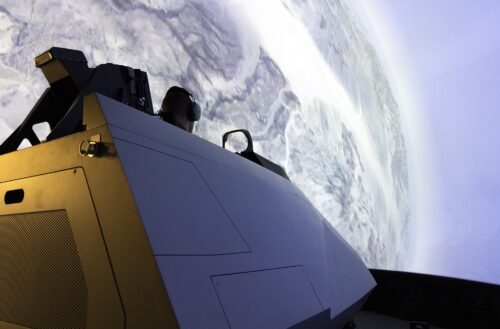In a significant advancement for U.S. joint military operations, Marine Corps F-35 and Air Force F-22 pilots trained together for the first time in the Naval Air Warfare Center Aircraft Division’s (NAWCAD) Joint Simulation Environment (JSE) at Naval Air Station Patuxent River during the last week of March 2025.

The four-day exercise, conducted Mar. 24-27, brought eight Marine Corps F-35s together with four Air Force F-22 Raptors in what officials describe as the Department of Defense’s most advanced digital test and training range. This event marks a crucial step toward greater interoperability between different military branches operating fifth-generation aircraft.
“This milestone ushers in a new era of interoperability for aviation’s combat community and served as a pivotal exercise getting NAWCAD ready to make this joint training standard for Navy and Air Force fighters,” said NAWCAD Commander Rear Adm. John Dougherty IV.
The JSE was initially developed to support F-35 Lightning operational testing, addressing the challenge of adequately representing real-world conflict scenarios that couldn’t be safely replicated on open-air ranges. Since its inception, the facility has evolved into a comprehensive simulation environment equipped with actual defense hardware, software, and adversary aircraft simulations.
In January 2024, NAWCAD expanded the JSE’s capabilities by installing a division of four U.S. Air Force F-22 Raptor cockpits alongside its existing division of eight F-35 Lightning cockpits. This addition has enabled pilots from Navy, Marine Corps, Air Force, and allied partners to train together in a virtual environment that closely mimics real combat conditions.
During the recent exercise, F-35B and F-35C pilots from Marine Fighter Attack Squadrons (VMFA) VMFA-122, VMFA-225, and VMFA-311 conducted 17 simulated combat missions over two days against advanced enemy threats available only in the JSE. After each mission, pilots reviewed their performance using cockpit video and audio recordings to refine their tactics and improve coordination.
“The cross talk while training in the JSE is unparalleled in terms of being able to discuss tactics and actually get in the same room with people,” said F-22 pilot Capt. Brett Myer. “It helps iron out a lot of the small details that really matter when it comes down to it.”
Major Patrick Hoffer from VMFA-225 emphasized the human element of the training: “At the end of the day, it’s going to be the people that win our nation’s wars. Having those person-to-person connections between the Air Force, the Navy and the Marine Corps in the JSE is the most important part and biggest objective that we’re able to achieve.”
The JSE offers several advantages over traditional open-air range training. It is more cost-effective, allows for a higher volume of sorties, and creates realistic threat environments that cannot be replicated in real-world training. According to NAWCAD, tactical groups training in the JSE fly more sorties in one week than they fly over a year on open-air ranges.
The hyper-realistic digital range includes cockpits, domed simulators with 4K projectors, and aircraft software that enables pilots to experience the consequences of their actions, including mission failure, loss of systems, and simulated loss of life. This environment allows pilots to learn from mistakes, make immediate adjustments, and continue developing their skills.
The program’s expansion has not been without challenges. A comparison of NAWCAD announcements from 2024 and 2025 reveals adjustments to the implementation timeline for additional aircraft simulators. Initial plans announced in April 2024 called for rapid integration of F/A-18 Hornet, EA-18 Growler, and E-2 platforms within the year. However, current projections now indicate the E-2D Advanced Hawkeye will be added in 2025, with the F/A-18 Super Hornet and EA-18G Growler following in 2026—approximately a one-year delay from the original schedule.
Despite these timeline adjustments, the JSE program continues to gain traction within the defense community. The Department of Defense has formally integrated JSE training into the Navy’s Strike Fighter Tactics Instructor Program, commonly known as TOPGUN.
Future plans for the JSE include deployment of a second training system aboard the USS Abraham Lincoln (CVN 72), further enhancing the Navy’s carrier-based training capabilities.
For more information, hit the Source below